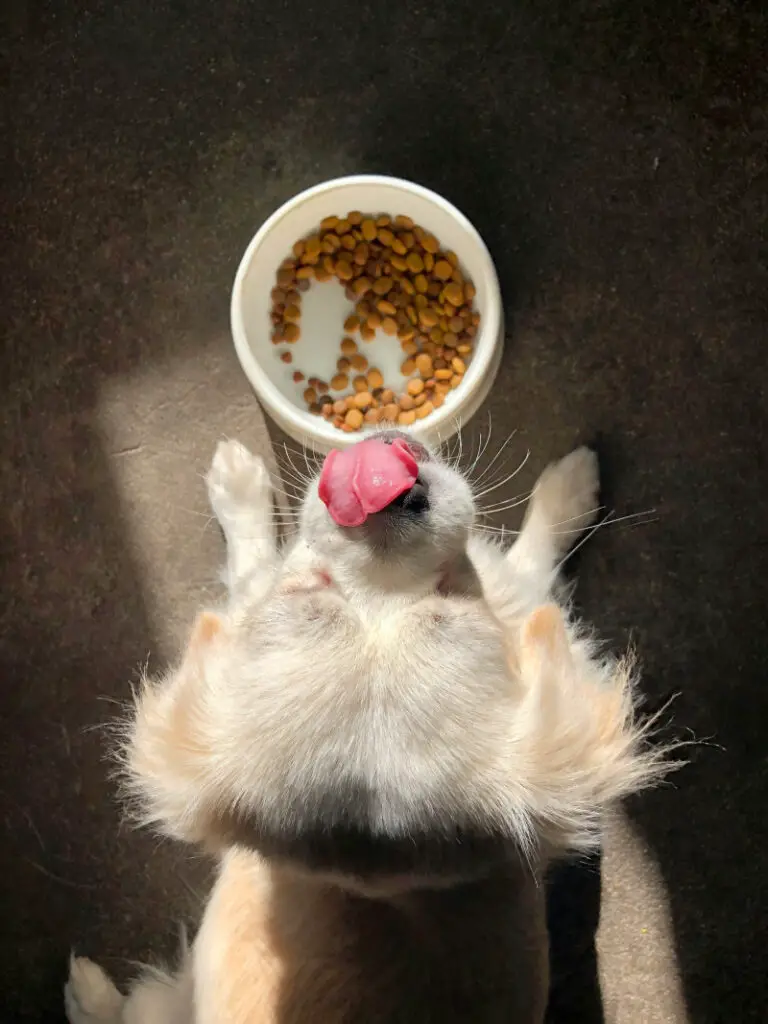Dogs love to eat their owner’s food, and we’re happy to spoil them with a bite of whatever we’re eating. But unfortunately, this is not safe with all foods. Did you know that some common fruits and vegetables are not suitable for consumption by dogs? A good example of this is the grape.
Why can’t dogs eat grapes? As an owner, it is important that you never give your dog grapes. Both fresh grapes and raisins are considered toxic to dogs and can cause serious reactions, even death.
Keep reading below to learn everything you need to know about dogs and grapes: the dangers of consuming grapes in dogs, common symptoms, the smallest portion of grapes that causes toxicity, steps to take in cases of ingestion, as well as other tips, warnings, and preventive measures.
Table of Contents
Why can’t dogs eat grapes?
As we mentioned at the beginning, dogs should never eat grapes. All types of grapes, whether fresh, dried or peeled, are considered toxic and are highly contraindicated for these animals. It is not yet known for sure what causes this reaction, nor why some dogs experience more severe symptoms than others.
Unfortunately, grape toxicity can sometimes be fatal. A dog that eats the fruit can be poisoned and therefore at high risk of developing sudden and acute kidney failure. This can happen in any dog; no matter the gender, race, or age.
Reportedly, the discovery was made thanks to the recognition of a pattern in different reports of sick dogs. After analyzing the records, it was observed that they all had something in common: the ingestion of grapes or raisins.
Researchers have not been able to confirm which substance(s) present(s) in the grape have poisonous action in dogs, on the one hand, there are those who suspect a mycotoxin (a toxic substance produced by a fungus or mold), and on the other, those who say the toxicity is caused by a type of salicylate (similar to aspirin or aspirin) found naturally in grapes. Apparently, this compound causes a decrease in blood flow to the kidneys.
But the truth is that, to date, none of these theories has been confirmed.
How much grape is considered dangerous?
Some people use to give a few grapes to the dog as a gift or reward, but this is a totally inadvisable act. Several studies have noted that the toxicity of grapes and raisins is an effect that is highly dependent on the size of the dog and the dose ingested.
What does this mean?
In other words, a large dog may not experience severe or immediate symptoms after eating 2-3 grapes, while a small dog may develop severe symptoms after eating just one.
How many grapes are toxic to a dog?
The following rule of thumb helps determine what could be a dangerous serving of grape …
- 10-pound dog: 1 or 2 grapes
- Dog 20 pounds or more: 3 or 4 grapes
How many raisins are toxic to a dog?
- 10-pound dog: 0.7 ounces of raisins
- 20-pound dog: 1.4 ounces of raisins
- 30-pound dog: 2.1 ounces of raisins
- Dog 40 pounds or more: 2.8 ounces of raisins
Being more concentrated, a small amount of raisins is needed to observe severe reactions.
Note. The amounts mentioned above are approximate. The effect of a particular serving can vary depending on the dog. In general, it is safest not to give them grapes.
Grapes and raisins should never be given as a treat. The amount of 1 or 2 grapes may seem completely harmless, but the reality is that it is enough to cause serious symptoms, or worse, death.
Likewise, it is important not to leave them within the reach of your dog. The pet may be tempted to try them simply because she is seeing them.
See also: What Fruits and Vegetables can Dogs Eat? Which ones are prohibited?
What are the symptoms of grape toxicity in dogs?
A dog intoxicated by ingesting 1 or more grapes/raisins may exhibit any of the following unusual signs and symptoms:
- Decreased or complete loss of appetite
- Lethargy, weakness, extreme calm
- Vomiting and/or diarrhea (within a few hours after ingestion)
- Abdominal pain (tender to touch)
- Dehydration (dry nose and mouth, wheezing, pale gums)
- Increased thirst and urination
- Decreased or absent urine output
Risks and complications: what can happen if a dog eats grapes?
In addition to these symptoms, the dog can experience serious adverse effects, such as kidney failure, a complication that often leads to death. This is especially true if the pet does not receive any type of treatment.
As reported by a WebMD post, one of the earliest clinical signs of canine kidney failure is increased water intake and urination. Once most of the kidney tissue has been damaged, there is a sudden increase in waste products circulating in the bloodstream.
In case of more advanced kidney failure, the dog begins to show loss of appetite, depression, vomiting, diarrhea, and very bad breath. Occasionally, ulcers can be seen in the mouth.
Recommended:
- Why Does My Dog Have Diarrhea and Vomiting? What I can do?
- Does your dog have vomiting? Causes, Types of Vomiting, and Treatment
What to do if your dog has eaten grapes?
Grape ingestion in dogs should be addressed immediately. In these cases, timely treatment is considered critical to avoid long-term complications. The recommendation is to contact the veterinarian as soon as possible, who will surely indicate to induce vomiting in the dog.
Note. Inducing vomiting is not recommended if the dog is having difficulty breathing, is showing signs of distress, is unconscious, or if you are not sure what the animal has eaten.
Specifically, in veterinary consultation, the same procedure is usually followed. Vomiting is usually first induced to remove the fruit from the dog’s system, followed by a dose of activated charcoal.
After this, there is no special antidote to treat grape or raisin poisoning. The veterinarian will be able to start a support plan to strengthen kidney function, administering fluids and medications intravenously for 48 hours.
It is also common for blood tests, urine tests, and ultrasounds to monitor the health status of the pet.
See later: How to Make a Dog Vomit at Home? Safe and Quick Remedy
Useful tips: How to prevent your dog from eating grapes?
Taking the following steps at home can help prevent your dog from getting food poisoning from eating grapes or raisins:
- Avoid leaving grapes and raisins on open counters or pantries where the dog can get to them.
- If you have children, be sure to explain to them the importance of not giving the pet grapes, as well as not leaving fallen grapes on the ground.
- If you’re hosting a dinner party and plan to serve grapes, remind everyone not to give them to the dog.
- Read the label of any food that is not specially designed for canine consumption. Check that the ingredients list does not contain grapes, raisins, or other harmful foods.
- Never offer grapes or raisins to a dog. Although just 1-2 grapes may seem harmless, it is enough to cause symptoms of poisoning.
See: 9 Potential Dog Poisons – What Can Poison My Dog?
Quick Answers to Frequently Asked Questions
What types of grapes and raisins are toxic for dogs?
As veterinarians and other experts warn, all types of grapes and raisins are harmful to the health of dogs. Cases of intoxication have been recorded after the consumption of red, green, black, and white grapes, seeded and seedless grapes, commercially grown and home-grown, organic and non-organic, with skin and peeled.
Any food that contains grapes or raisins, eg cookies, cereal, granola, trail mix, or baked goods, should be viewed as a potential poison.
Can a single grape kill a dog? Will my dog be okay if he only ate one grape?
Although the damage caused by 1 grape can vary from dog to dog, veterinarians warn that 1 grape can be enough to cause kidney failure and in some cases, death. The recommendation is clear: dogs should not eat grapes, not even one.
How many grapes can kill a dog?
When it comes to the toxicity level of grapes for dogs, the dangerous amount can be as little as a 1-2 grape serving. A small breed dog can suffer from serious poisoning if they eat only 1 grape, while a larger dog can get complicated and die after eating only 3 or 4.
How quickly can a dog get sick after eating grapes?
If a sensitive dog has ingested a toxic amount of grapes or raisins, it is very likely that he will begin to show the first symptoms of poisoning within 24-48 hours. The pet may present vomiting, diarrhea, lethargy, and lack of appetite in the first 12-24 hours.
Both vomit and feces may contain traces of grapes.
Should I make my dog vomit if he ate grapes?
If it is certain that a dog has eaten raisins or grapes in the last 2 hours, its owner should induce vomiting as soon as possible. This will help remove any leftover fruit before it can be fully absorbed.
If your pet is having trouble breathing, seems stressed, or you’re not sure they actually ate grapes, it’s not advisable to make them vomit. It is best to go or consult the veterinarian.
What is the toxic dose of grapes?
Unfortunately, there is no established toxic dose of grapes for all dogs. The two main principles to keep in mind are:
- A dog is more likely to be poisoned if it ingests large amounts of grapes.
- There is significant individual sensitivity; Some dogs seem to tolerate small doses of the fruit without consequences, but others can develop severe intoxication after eating just a few. There is no way to predict which dogs are the most sensitive.
Is there an antidote for canine grape poisoning?
No. So far there is no anti-toxin medicine capable of curing the problem. The best treatment available is to try to detoxify the dog immediately through the induction of vomiting and the administration of activated charcoal.





